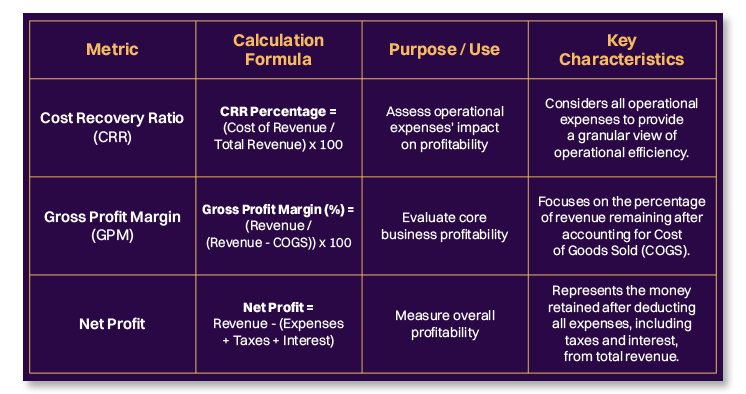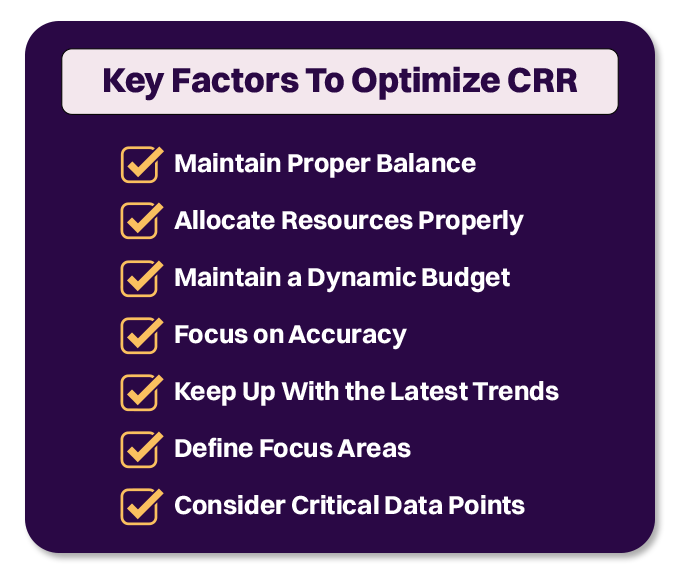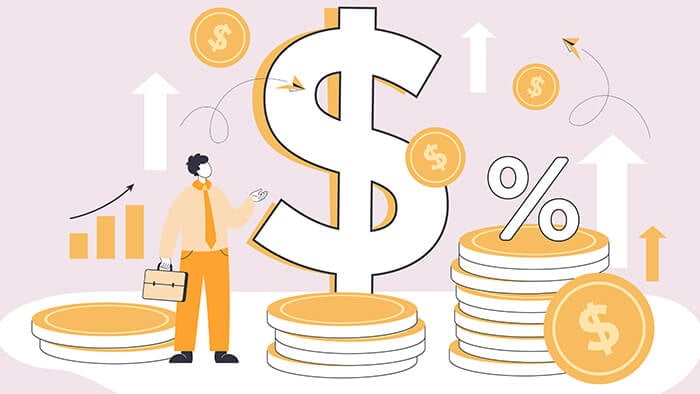
How to Calculate Cost Revenue Ratio (CRR): Your Go-to Guide
Whether you’re a revenue officer, marketer, or company owner, your end goal is to assess your company's efficiency. Hence, you need to know about the primary key performance indicators (KPIs) related to finance.
As businesses navigate the complexities of the marketplace and make informed decisions, the Cost Revenue Ratio (CRR) serves as a strategic tool that empowers them to achieve their growth objectives. It's more than just a financial metric - it's a financial compass that guides data-driven growth and leads businesses towards a brighter and more profitable future.
So, today, we'll get into the explicit details of the Cost Revenue Ratio – what it means, how to calculate it, and, most importantly, how to optimize it. Well then, let's proceed, shall we?
What’s CRR in B2B Businesses?
The Cost Revenue Ratio (CRR) or expense-to-revenue ratio measures your company's operating expenses relative to its generated revenues. Its primary objective is to pinpoint potential excessive spending. Hence, CRR ensures your company generates more revenue than it allocates to its operations.
CRR reveals the cost of acquiring and retaining customers and the revenue they generate. Marketers can optimize campaigns, sales leaders can make informed decisions, and founders can have a financial dashboard for strategic decision-making.
Chief Revenue Officers (CROs) like you should assess this metric monthly as a standard practice. CRR aids your B2B firm in striking a harmonious equilibrium between these two elements:
- Its overall sales
And - The financial resources dedicated to sustaining its day-to-day activities
Why Is CRR Important?
In B2B, where every dollar counts, understanding and applying CRR is crucial. Here’s why:
- Efficiency Assessment: CRR acts as a barometer for efficiency, revealing whether expenses effectively contribute to revenue.
- Cost Optimization: Keeping CRR in check is essential for cost optimization while maximizing revenue – a crucial balance in B2B success.
CRR vs. Traditional Profit Metrics
When assessing your business's financial health, you consider various profit metrics. Two commonly used metrics include Gross Profit Margin and Net Profit. Let's now explore how CRR stands out from these conventional measures:
CRR vs. Gross Profit Margin (GPM) vs. Net Profit
 CRR: CRR considers all operational expenses. Thus, it gives you a more granular view of how your company's operations impact profitability. But before that, you need to find out the total cost of revenue.
CRR: CRR considers all operational expenses. Thus, it gives you a more granular view of how your company's operations impact profitability. But before that, you need to find out the total cost of revenue.
CRR Formula:
[CRR Percentage = (Cost of Revenue / Total Revenue) x 100]
What's the cost of revenue? It's all the direct costs of your business.
- Gross Profit Margin (GPM): This metric evaluates core business profitability. How? By measuring the percentage of revenue remaining after accounting for the Cost of Goods Sold (COGS).
Formula:
Gross Profit Margin (%) = Revenue / (Revenue − Cost of Goods Sold) ×100
Example:
- Revenue: $100,000
- COGS: $40,000
GPM = 100,000/ (100,000 − 40,000) x 100
GPM = 60%
- Net Profit: Net profit, or the bottom line, represents the money retained after all expenses (including taxes and interest) are deducted from total revenue.
Formula:
Net Profit = Revenue − (Expenses + Taxes + Interest)
Example:
- Revenue: $200,000
- Expenses: $100,000
- Taxes: $20,000
- Interest: $10,000
Net Profit = $200,000 - ($100,000 + $20,000 + $10,000)
Net Profit = $70,000
Beyond CRR: Comprehensive Financial Analysis in B2B Sales
Now, several complementary metrics can work alongside CRR to get the most out of your sales initiatives. Let’s check out two such vital metrics:
Cost of Goods Sold (COGS)
COGS represents the direct costs associated with producing or procuring goods your company sells during a specific period. It includes expenses like:
- Raw materials costs
- Labor payments
- Manufacturing expenses
– directly related to producing the products.
When used in conjunction with CRR, COGS provides insights into the following aspects:
- The efficiency of your production process.
- How your manufacturing process affects profitability.
Cost of Sales
The Cost of Sales includes the COGS and additional costs like:
- Sales team salaries
- Marketing expenses
- Distribution costs
When combined with CRR, this metric offers a more comprehensive view of how various sales-related expenditures impact profitability.
Cost to Sales Ratio Formula:
[(Cost of Sales (COGS) / Total Revenue)x 100]
Why Does Unique Perspective CRR Offer on Sales Performance?
Let’s now discuss why CRR is a must-have metric to get a distinctive viewpoint on sales results:
- Comprehensive Cost Assessment: CRR accounts for all operational costs, including direct and indirect expenses. Hence, it provides a holistic view of cost management.
- Operational Efficiency Focus: CRR highlights how effectively your business turns costs into revenue. It's particularly valuable for your B2B business – where operational excellence is critical.
- Early Warning System: A rising CRR may indicate operational costs are rising faster than revenue. Hence, it ends up prompting proactive cost-cutting measures.
How to Calculate Cost Revenue Ratio?
Let’s now explain how to compute CRR for your firm.
Now, the above calculation seems quite simple, right? However, you need to consider several elements here. So, let’s break it down for you:
Step 1: Consider All Costs
To calculate CRR, begin by identifying and considering all costs (variable + fixed) associated with your business operations:
- Labor Costs: The expenses related to employee salaries and wages.
- Marketing and Selling Expenses: Costs incurred in promoting and selling products or services.
- Material Costs: The expenses for raw materials or components used in production.
- Taxes and Administrative Expenses: Admin and regulatory costs, including taxes.
- Production Expenditures: Costs associated with the manufacturing process.
- Distribution Costs: Expenses related to the transportation of products.
NOTE: To determine your variable costs, account for all production expenses. You can get these numbers from your financial statements, like balance sheets.
Step 2: Find the Cost of Revenue
Add up all the costs identified in Step 1 to calculate the total cost incurred by your business.
Step 3: Calculate Your Total Revenue
Determine your total revenue – the gross revenue generated, before deducting any expenses.
Step 4: Calculate Cost Revenue Ratio Percentage
To calculate the CRR percentage, use the following formula:
CRR Percentage = (Cost of Revenue / Total Revenue) x 100
Now, let's illustrate this process with a hypothetical example:
Let’s say your company incurs the following costs:
- Labor Costs: $50,000
- Marketing and Selling Expenses: $20,000
- Material Costs: $30,000
- Taxes and Administrative Expenses: $10,000
- Production Expenditures: $40,000
- Distribution Costs: $15,000
Here:
Total Cost = $50,000 + $20,000 + $30,000 + $10,000 + $40,000 + $15,000 = $165,000
Next, let’s assume that you generate gross revenue of $220,000.
Then,
CRR Percentage = ($165,000 / $220,000) x 100 = 75%
Key Takeaways: In this context, the CRR percentage means your company incurs $0.75 in costs for every $1 of total revenue generated.
A higher CRR percentage suggests that more revenue is being spent on costs. It can impact profitability unless your company can scale its revenue effectively to offset these costs.
Advanced CRR Scenarios in B2B Sales
As a B2B revenue officer, you'll encounter several advanced scenarios that demand a nuanced approach to the Cost Revenue Ratio. Here's how you can tackle them effectively:
Complex Pricing Structures
- Multi-Tiered Pricing:
In B2B sales, it's common to have multi-tiered pricing models. Different customer segments or usage levels are charged varying rates in this scenario.
When calculating CRR in such scenarios:
- Consider the distinct revenue streams generated from each tier.
- Ensure your CRR formula includes the specific cost-to-revenue relationship associated with each pricing tier.
- Subscription Models:
If your business offers subscription-based services, you'll need to factor in the following elements:
- Recurring revenue over time
- Churn rates
- Customer acquisition costs
A comprehensive CRR analysis should consider these dynamics to gauge the long-term financial health of your subscription-based business model.
Adapting the CRR Formula
- Industry-Specific Considerations:
Different B2B industries have unique cost structures and revenue recognition methods. When applying CRR, tailor the formula to account for industry-specific factors.
For example, manufacturing businesses focus on cost per unit produced. On the other hand, software-as-a-service (SaaS) companies emphasize customer acquisition costs and lifetime value.
- Product or Service Variations:
If your company offers diverse products or services, you must tweak your CRR formula accordingly. Segment your CRR analysis by product or service category. You will then understand which offerings are more cost-effective and profitable.
- Geographical Variations:
In global B2B operations, costs and revenue can vary significantly across regions. Consider regional variations when calculating CRR. This is especially true if you have distinct cost structures or pricing strategies in different markets.
- Seasonal Fluctuations:
Some businesses experience seasonal fluctuations in revenue and costs. When analyzing CRR, account for seasonality to avoid skewed results. A yearly average or a rolling quarterly analysis can provide a more accurate picture.
Key Factors to Optimize CRR

Here are the critical elements for maximizing your Cost Revenue Ratio:
1. Maintain Proper Balance
- Balance cost-cutting with resource maintenance.
- Focus not only on cost reduction but also on revenue growth.
- Find the proper equilibrium between cost management and revenue growth. It is essential for a healthy CRR.
2. Allocate Resources Properly
- Analyze factors beyond customer size – such as deal size and true profitability.
- Aim for a CRR ratio below 1:1, where revenue exceeds costs.
- Invest in marketing strategies with a proven ROI.
3. Maintain a Dynamic Budget
- Continually tweak your budget to identify areas for improvement without sacrificing quality. After all, in finance, small changes can make a significant impact.
4. Focus on Accuracy
- Accurate data is vital for sound financial reporting and analysis.
- Avoid common mistakes like ignoring non-monetary benefits and underestimating implementation costs.
5. Keep Up With the Latest Trends
- Incorporate new solutions to boost productivity and enhance your CRR.
- Learn from success stories and case studies.
6. Define Focus Areas
- Focus on high Customer Lifetime Value (CLTV or CLV) segments. A substantial CLV may justify higher upfront costs.
- Avoid resource over-allocation and prioritize customer retention.
7. Consider Critical Data Points
- Embrace data analytics and ROI analytics to measure marketing channel effectiveness.
- Prioritize customer satisfaction and loyalty programs to reduce churn rates.
Adding to our tips, Matt Little, Co-owner of Damien McEvoy, says:
“It's important to remember that B2B CRR isn't a fixed number. It's constantly changing and requires constant attention and strategic planning. Companies can establish a balanced, long-term revenue model by understanding its complexities and adopting best practices.”
How to Use CRR for Customer Segmentation and Lead Generation
One of the most powerful ways to leverage CRR is by applying it to different customer segments. What you should do is – segment your customer base and analyze CRR for each segment.
Following this, you can tailor your sales strategies to cater to the specific requirements of different client profiles.
For example, high-value clients may warrant personalized services and higher investments. However, cost-conscious clients may require more budget-friendly solutions.
When you aim to generate business leads, you need to eliminate uncertainties in your profit calculations. Your goal is to align your sales targets precisely with your budget constraints. So, this is where CRR comes into play.
By now, you know that CRR estimates the balance between your costs and revenue. Hence, you can set a benchmark for selling your products/services using this number.
In simpler terms, you can gauge the expected profitability from generating/acquiring leads. As such, you can fine-tune your budgets and objectives accordingly.
At Revnew, we provide a range of advantages tailored to your needs. Our unique B2B lead generation strategies allow your business to streamline its sales processes. Therefore, you can easily align costs and revenues with your set goals and budget parameters.
Advanced Tips to Use CRR for Your Business Growth
Let's now explore some advanced tips to improve your CRR:
- Optimizing Sales Processes: Streamline your sales processes to eliminate bottlenecks and reduce unnecessary expenditures. Ensure your team operates efficiently to maximize revenue while minimizing operational costs.
- Cost Reduction: Identify areas where you can cut costs without compromising on quality. It might involve the following:
- Renegotiating supplier contracts
- Implementing more efficient technologies
- Optimizing resource allocation
- Upselling and Cross-Selling: Look for opportunities to upsell your existing clients. Offer higher-value products or services that meet their evolving needs. You can complement this with cross-selling complementary products or services – to increase revenue.
- Client Expansion: Explore opportunities to expand your client base. Target new markets or customer segments. Identify untapped markets where your offerings can provide value and generate additional revenue streams.
Final Word
CRR is a multifaceted metric demanding a comprehensive grasp of expenses and income. It extends beyond a basic formula – considering nuances like timing intricacies, concealed expenditures, and the relationship between cost management and revenue expansion.
However, when you completely understand these facets, your firm gains a competitive advantage over others.
As you already know – the most critical endeavor in life is to cease digging when you find yourself in a pit. This wisdom equally applies to managing the CRR – sometimes, it involves minimizing expenses but always centers on maximizing value.
We hope you now have a complete idea of what CRR is. However, if you have any further doubts, feel free to reach out to our team at Revnew. We will be happy to help!




